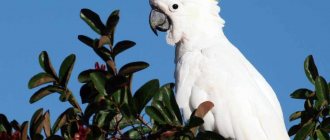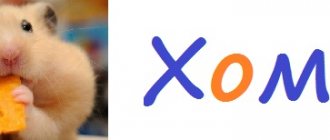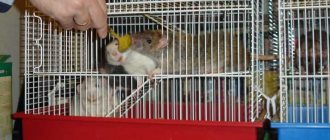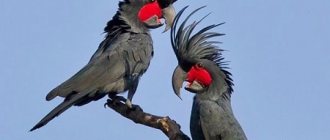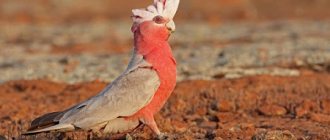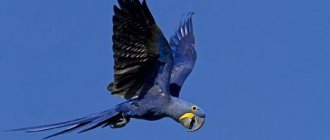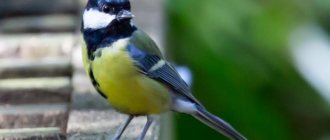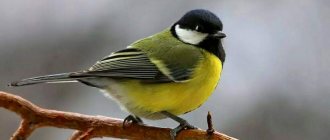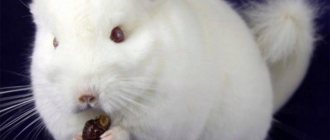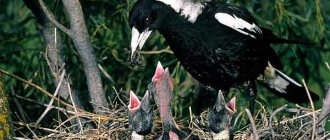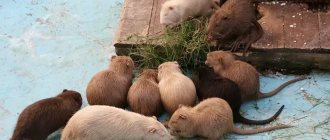- home
- Parrot
- Kinds
06/21/2019 The cockatoo is one of the most famous pet parrots. At the same time, this is one of the largest birds that you can keep at home, and one of the most beautiful. There are many species of Cockatoos, native to Australia, New Guinea, the Philippines and Indonesia. If you are thinking about buying this parrot as a pet, you should know that it requires more care than a dog. The bird needs to be fed twice a day and bathed once a day, given time to play, educated, delighted with treats and constantly kept in sight. If you give your pet warmth and care, he will become attached to you and remain a loyal friend forever. Forever, this is not a metaphor; in captivity, this bird lives up to ninety years.
Appearance of Cockatoo parrots
In the taxonomy of species, Cockatoo is a whole family, numbering 7 genera, which in turn are divided into 21 species of parrots. Many of them are kept at home, but, for example, Major Mitchell's parrot is now in short supply because Australian authorities have restricted the capture and sale of these animals.
Depending on the species, adults reach from 30 to 70 cm from the tip of the tail to the withers. A large parrot weighs more than a kilogram, so the bird needs a large cage and a decent amount of food.
Cockatoos are distinguished from other parrots by the absence of a bushy tail and the presence of a chic crest on the head, for which the bird is known and loved. These parrots also have a bizarre beak shape: it is large, and the beak curves so much that it looks like a sickle. The beak of these birds is very strong and breaks wooden rods without any problems. Don’t put your finger in a parrot’s mouth; a broken phalanx is a professional injury for breeders.
The cockatoo looks elegant. The plumage of a parrot is white, pink, red, black or yellow. Blue and green shades are not found in it. The crest usually contrasts in color with the rest of the body, as do the fine feathers around the eyes.
The cockatoo parrot is a poor flyer, but it makes an unsurpassed runner and tree climber. These birds boast intelligence not only among parrots, but among animals in general. They are not inferior in mental abilities to crows, dogs and dolphins. These are social creatures, constantly in need of attention.
Yellow-crested cockatoo
As you might guess, this species of parrot is distinguished by a bright yellow crest, contrasting with its white plumage. His “crown” is narrow, but high, consisting of individual feathers. Some flight and tail feathers also have a yellow tint. There are blue and white rings around the eyes.
Females are larger than males, reaching 980 grams of weight versus 930. Girls can be distinguished by their red-brown iris, which is black in boys. The yellow-crested parrot grows up to 60 cm, although there are individuals 40 cm in height.
Sulphur-crests live in northeastern Australia, southeastern New Guinea and several archipelagos. They love to wash themselves in streams of rain and settle near water. These birds easily learn tricks, which is why they have gained such popularity. By the way, the cockatoo is a talking parrot.
White-crested cockatoo
The most beautiful parrots of snow-white color, who take care that not a single spot remains on their plumage. The crest is also snow-white, it is tall and fluffy. Females can be distinguished by their red-brown eyes. Regarding yellow-crested birds, these are medium-sized birds, whose body length reaches 45 cm and weight – 600 grams.
The white cockatoo naturally lives in the forests of the Moluccas and Indonesia. Settles high in trees, not far from rivers. Learns simple tricks and remembers up to ten words.
Pink cockatoo
It has a second name: Gala, which translates as “clown”. They have interesting colors. Most of the body is light gray, the wings are somewhat darker. The chest, belly and lower part of the head are colored red-pink. The crest is white, slightly pinkish, combined with the scarlet color of the plumage. The eye color of males is much darker than that of females.
It lives in the savannas and fields of Australia, loves open areas and is therefore an excellent runner. The body length is relatively small, about 35 cm. At home, it lives up to 50 years. This is a peaceful species of parrots that easily gets used to humans.
Moluccan cockatoo
Beautiful motley parrot. The plumage is a soft light pink shade. The wings and tail below are yellow-orange. The crest curves bizarrely back. It is white on the outside, but bright scarlet and orange on the inside. The skin around the eyes is slightly bluish. Boys are larger and have a more massive beak. The iris of males is black, and that of females is brown.
In nature, the Moluccan cockatoo lives in the forests of only two islands in Indonesia: Seram and Ambon, which are part of the Moluccan archipelago. This is where the birds borrowed their name. These are large parrots, up to 55 cm in length and weighing up to 900 grams. They have been in the Red Book for half a century, so getting them on the market is not easy.
Goffin's cockatoo
Bright white plumage with pink feathers near the beak and pale yellow underneath the tail and wings. The color of the beak is unusual; it is light gray in color. This is a small pet, not exceeding 300 grams and 32 cm in length, living in Indonesia. Unfortunately, these birds are becoming extinct due to human intervention.
Major Mitchell's cockatoo
Known by other names as Mitchell's cockatoo or Inca's cockatoo. It is generally accepted that this is the most beautiful and colorful of all cockatoos. A soft light pink chest that can vary to bright pink, a blood red area around the beak, snow-white wings and an amazing tri-colored crest. Moreover, each feather has three colors, from the white tip becoming scarlet and then orange. The beak is light gray in color. The male can be identified by the dark iris of the eye.
This parrot weighs up to 440 g, females are slightly larger than boys. Mitchell does not grow more than 40 cm in length, therefore he is classified as a medium-sized parrot. In order to preserve these amazing birds in the wild, the Australian authorities have introduced a ban on their capture and sale. To keep an Inka cockatoo in this country you will have to pass a special exam. Finding such a bird on the market is almost impossible. This is also a talking cockatoo parrot.
Intelligence
In the parrot family, the cockatoo is considered one of the most intellectually developed. He has a good memory, a logical mind, and conversational talent.
Epithets characterizing cockatoos:
- Cunning. He can pick a complex lock, steal and hide an important thing, do something nasty, and then pretend that he is not guilty. Can solve puzzles. Capable of cunningly luring out a treat, even if punished.
- Revengeful. He remembers the evil done to him and returns it in an increased size. Being offended, he does not make contact, refuses food, ignores toys and treats.
- Talkative. He is still able to remember and pronounce a few dozen words, but this parrot speaks much worse than the gray parrot. However, the desire exceeds the ability, and the cockatoo bird chatters incessantly - “what I see, I sing.” She is much better at imitating animals and reproducing various noises.
- Sentimental. There is no parrot more gentle and affectionate than a cockatoo. This can be compared to the manifestations of a dog’s feelings for its owner. You need to see how the bird climbs to hug its owner and courtes the object of its love in every possible way - nothing could look more touching!
- Affectionate. He never gets enough attention from his owner. The parrot wants to participate in everything. To tame the pressure of the bird, breeders recommend getting a second cockatoo - in this case, the emphasis should shift to a partner.
- Demonstrative. If the bird doesn’t like something, it will scoop up food from the container by the handful and throw it to the bottom of the cage. After cleaning carried out by the owner, he deliberately tears the paper, scatters greens around the cage, and drops droppings wherever necessary. He shows dissatisfaction with his entire appearance: he spreads his crest, puffs up his wings, tilts his head, hisses.
- Loud. Expresses emotions very loudly. It is worth noting that cockatoo owners often have problems with their neighbors. Such a noisy bird is difficult for everyone around to tolerate. It only becomes silent in complete darkness.
- Careless. In games, in a fit of emotion, he does not restrain himself - he can bite painfully, hit with his paw or wings. Perhaps everyone who has a cockatoo in their home has “battle” scars received from their pet.
On a note! The cockatoo is an excellent manipulator. He notices the owner’s weaknesses and uses his knowledge with pleasure. Can express demands by shouting until he gets what he wants.
Other types
Banks' cockatoo is another species that is illegal to catch in Australia. This parrot is black, which gives it a mournful appearance. The bird is large, growing up to 65 cm and a kilogram in weight. By the way, although black is found among parrots, Banks' cockatoo is the only one that is completely black-headed.
Helmeted Cockatoo. It has gray-crimson plumage, unassuming compared to other species. A medium bird, up to 35 cm in length and 250 g. In captivity they live up to 40 years.
Spectacled cockatoo. It has a white color, bright blue rings around the eyes and a lemon-yellow crest thrown back. Reaches 50 cm and 900 grams of weight, which allows it to be classified as a large parrot.
The Philippine cockatoo has intelligence and white feathers. The tail is red below. Adult birds grow up to 32 cm and 250 grams. Despite its size, it can live up to 80 years in captivity.
Corella or western big-nosed parrot
These are playful, intelligent and funny parrots. Cockatiels are rarely kept outside of Australia and rarely breed in captivity.
Like other bare-eyed species, Western nosed cockatoos can drive themselves into a frenzy, causing them to take their anger out on their partner. Cockatiels are very active and can be aggressive, so they should be kept in spacious enclosures with plenty of toys.
Western nosed cockatiels run with fast, mincing steps, and spend the night in large flocks in trees growing near water, with other species of parrots.
Cockatoo in the wild
These are social birds. One flock can contain from 30 to 800 individuals. Numbers vary, but no species of cockatoo lives alone. Parrots retire only to breed, which lasts three to four months, after which they gather again in a flock.
These birds are monogamous, they pair up for life, and prefer as partners those they have known since childhood. The lovers help each other with daily chores, spending hours preening each other's feathers. This explains their endless devotion to their owner. Cockatoos are able to distinguish their relatives by their voices and have complex behavior: while some individuals collect food on the ground, others make sure that the predator does not sneak up unnoticed.
Habitat
Fans of exotic birds know which continent the cockatoo lives on. Their natural range is limited to Australia and nearby archipelagos. Eleven species are found on the mainland, while seven species can be found in Indonesia, the Philippines and the Solomon Islands. Three species are found both on the islands of New Guinea and on the mainland. The easiest way to tell is where Goffin's cockatoo lives in the Tanimbar Island group. However, a few specimens were introduced to Singapore, where they multiplied and established populations outside their native range.
Judging by the distribution, each species has its own habitat. Some crested parrots prefer open landscapes, others live in tropical forests, and still others prefer urban areas. Indonesian cockatoos live in wetlands. The nomadic species remain in south-west Australia during the breeding season and move to cooler coastal areas in summer.
Eating at home
An indiscriminate eater, the Cockatoo bird will eat whatever you give it. Therefore, you should not rely on the principle “the animal itself knows what is best for it.” Monitoring the diet is the responsibility of the owner. Correctly the menu contains:
- grain mixture including oats, millet (white, yellow, red, black), wheat, sunflower and pumpkin seeds, young corn, rice
- apples without peel and seeds
- pitted oranges
- carrots, grated or pieces
- dog-rose fruit
- bananas without skin
- cabbage and lettuce leaves
- grass
- young leaves of fruit trees
- young twigs
As food, the parrot should be given chalk, sepia, mineral stone, shell rock, and during molting, add a pinch of sulfur to the food on the tip of a knife.
Cockatoos should be fed twice a day, one in the morning and one in the evening. Chicks should be fed 3-4 times a day as their metabolism is faster. The water in the bird's cage should always be clean. The bowl is washed every day, otherwise your pet may get sick.
Breeding
Cockatoos have a rather difficult time getting along with each other, so it is best to purchase a pair of young birds of different sexes and keep them together until they mature; in this case, the formation of a strong couple is most likely. For the same reasons, it is quite difficult to find a mate for a cockatoo that has lost its partner.
V.A. Grinev describes the amazing life of free-living large yellow-crested cockatoos in Askania-Nova: “In the Askania-Nova reserve at the beginning of this century, a pair of large yellow-crested cockatoos, in conditions of absolute freedom, bred 2 chicks for 2 years in a row, and these 6 large white birds flew for several years feed on fields of wheat, barley, oats, etc. Like pigeons, they stayed in a flock all the time.” There is evidence of the breeding of this species under artificial conditions by S.K. Gulbe and A.P. Gileva.
This happened at the Riga Zoo in the period 1983-1985. A pair of birds were placed in a room consisting of two adjacent enclosures - an external one and an insulated internal one. These authors consider the presence of high air humidity in the interior, not lower than 80%, to be an important condition for the reproduction of parrots. Indeed, in dry rooms, the shell shells dry out, their gas permeability decreases, as a result of which the embryos die. The nest house was small (38x34x34 cm), made of thick multilayer plywood, with a 10x12 cm entrance. At the bottom of the house there was a layer of sawdust. Over the course of three nesting seasons, the birds laid eggs in November, August and July. Each clutch contained 2 eggs. In the first clutch, one egg was unfertilized, and in the second, the embryo died. But the second and third nestings ended successfully: each time the birds raised two chicks.
Proper nutrition
The authors also consider proper feeding of cockatoos to be an important factor in successful bird breeding. The birds were given soft and grain feed; the diet per bird consisted of the following components: boiled egg (1/4 part), rice porridge (15 g), boiled meat (20) and corn (15), wheat bread (15), sweet fruits (50), vegetables (30), berries (50), greens and milk (30 each), cottage cheese (10), dried fruits and compote (40 each), walnuts (20), sunflower (10), oats (20), wheat (15 ), corn (20), sprouted grain (10 g). Calcium, phosphorus and microelements, vitamins A, D3, E were always added to the food. Lump salt, shells, chalk and gravel were constantly present in the enclosure. Assessing this rich diet, it should be recognized that many breeders do not give pure salt to their birds, believing that it can harm them. You can also recommend giving parrots twig food. They not only serve as a source of additional vitamins, but also give the pet something to do, distracting him from the boring sitting on his little seat.
Cockatoo cage
Cockatoos have a very powerful beak and this must be taken into account when purchasing a cage. The cage should be large and spacious so that the parrot can flap its wings freely. The cage must be closed with a large, reliable lock; the cockatoo is very smart and can open simple locks in no time. The rods are very strong and thick. Dimensions: width – 80 cm: height – 90 cm; length – 80 cm; The cage should contain branches for gnawing and calcium for grinding down the beak. The cage should be located in a well-lit room and closed from drafts.
Cockatoo feeding
Proper feeding is of great importance for proper development and growth. The main diet for cockatoos is grain mixtures. Try to diversify your cockatoo's diet. The grain feed should consist of millet of various varieties, buckwheat, canary seed, some nuts, seeds and hemp.
- Fruits for the parrot. Strawberries, raspberries, pears, rose hips and apples are suitable for cockatoos. Not all parrots eat fruit right away - they need to be taught. It is better to cut large fruits so that the parrot can take a piece in its paw. Leftover fruit must be removed every day.
- Vegetables for the parrot. Parrots can be given carrots, cucumbers, eggplants and celery. Dandelion roots will work well. Green beans and pea pods, red beets, fennel and other vegetables.
- Animal food. Protein plays a big role for cockatoos. It is better to feed boiled chicken meat. In addition, cockatoos can be given yogurt, cottage cheese, and cheese.
Cockatoos may refuse any food except sunflower seeds, but it is necessary to accustom the birds to a variety of foods. This is easier to do when transferring the chicks to an adult diet. Limit your pink cockatoo's fat intake to reduce the risk of tumors.
Toys
Cockatoos need visual variety and intellectual stimulation. Toys will help satisfy the needs of these curious beaks and give them the opportunity to independently entertain themselves and develop, but they should not be meaningless. The “right” toys for cockatoos are those that make you want to take them apart (pyramids, puzzles), sort them out, untie knots, toss them (rings, balls) and make sounds (bells, rattles). Toys must be made from safe materials: wood, coconut or sisal fiber, or hard plastic.
Diseases
Self-plucking is one of the most common, painful and unpleasant diseases of cockatoos, which can be caused by:
- In most cases, an unbalanced and monotonous diet, in which several specific components predominate (for example, sunflower seeds), this leads to metabolic disorders in the body and, as a result, to self-plucking.
- Treating a parrot with ointment. A feather smeared with a greasy substance loses its properties, so the bird tries to clean it and if it fails, it simply pulls it out. Accordingly, if the ointment is applied to a large area of the plumage, the parrot will not calm down until the entire affected area is eliminated.
- Environmental factors: room temperature too high or too low, humidity, close proximity to a strong light source, or inability to swim.
- If the cockatoo does not have a mate: boredom and lack of communication.
- External parasites: lice eaters, pereaters, scabies mites, fungi and others. The real probability of a “domestic” parrot becoming infected with ectoparasites is minimal, because indoor birds have no contact with wild fauna.
Self-plucking is dangerous because it can turn into a habit that not only brings pain to the bird and deprives it of its plumage, but is also harmful to health. The feather follicle often bleeds, this bothers the bird and excites others who are in the same cage; sometimes self-plucking leads to cannibalism.
It is almost impossible to establish the cause and independently prescribe effective treatment at home. A bird with self-plucking syndrome needs qualified examination and treatment.
Captivity
You will have to keep a cockatoo at home in a cage or aviary. Large parrots require a lot of space, medium ones need a little less. If there are two or more birds in one cage, the space should be proportionately larger. The size of a suitable cage for a parrot is 120 in height and 90*120 in bottom area. For an enclosure you will need a space the size of half a small room: 6 meters by 2 by 2 in height.
The cage must be metal, made of rigid rods. With its powerful beak, the winged friend is capable of carving a hollow in a tree trunk, not to mention breaking thin twigs. The cockatoo cage does not have a latch; a smart parrot can easily open it. Instead, it is recommended to use a small, strong lock with a key. A padlock with a combination may work, but there is always a risk that the bird will guess the correct code by accident.
Comfortable temperature for feathered pets ranges between 15 and 20 degrees. Humidity should be kept high. For plain parrots it is at least 75%, and for those who live in swamps or jungles - all 90%. To achieve these conditions at home, it is best to purchase a humidifier.
It is best to build several perches for the parrot in the enclosure, at least two, and a house of a suitable size. To prevent the bird from getting bored, the cage should be decorated with a variety of toys. It is best to buy them at a pet store, since manufacturers guarantee that the toys are safe for birds. Additionally, put a “rodent” in the cage
In winter, it is not recommended to place the cage near heating radiators, since they emit very dry hot air. In summer, care should be taken to ensure that the bird has shelter from direct sunlight.
For cockatoos, keeping them is impossible without water procedures. You should bathe your parrot at least once a day. Some birds like a tray with water, some like to wash themselves in the shower. It depends on the nature of the bird. If your pet refuses, you can spray it with a spray bottle.
Before you get a pet, you should know that these birds scream very loudly. Soundproofing partly solves this problem, but given the bird's lifespan, it doesn't hurt to be mentally prepared to live life with this always noisy child.
Finally, the winged pet becomes very attached to its owner. If left alone for three weeks or a month, the bird will become depressed, begin to pluck its feathers, refuse to eat, and may even die. They say that some sailors took them with them on their journeys.
What is a bird
The cockatoo is a sociable and intelligent bird that requires difficult care. This is a flocking creature, therefore, at home, a person is perceived by him as a member of the flock, and the parrot communicates with him, which is expressed in sounds, gestures and facial expressions, as far as this is applicable in this case.
Before purchasing a cockatoo, you need to think carefully about whether it can receive proper care and attention, and whether the owner has the intelligence and ingenuity to stop attempts at vandalism by the pet.
Introduction to the Cockatoo parrot
Cockatoo bite
The cockatoo also feeds on hard nuts, but this is not what the bird's strong beak is for. Cockatoo literally means “biting”. As mentioned above, the bird uses its sharp beak for cracking nuts, expanding natural hollows in which it nests and for self-defense. An angry parrot can break a person's finger with one bite or tear out a piece of skin and meat.
Parrots are quite curious and impulsive birds. Cockatoos, on the other hand, have a personal character, preferences, understand the boundaries of personal space and have excellent memory. If you offend a bird, sooner or later it will take revenge on you.
However, parrots do not always bite when irritated. The parrot may get scared and not calculate its strength. Therefore, if there is a child in the house, taking a cockatoo is contraindicated. Their meeting could lead to trauma for both.
But even without touching on the possibility of tragic consequences, reviews from owners indicate that keeping a cockatoo at home often leads to damage to furniture, indoor plants and anything that was not removed in time.
Peculiarities of habits
Temperament and curiosity are the main characteristics of cockatoos. When kept at home, this transforms into love and mischief. The first is accompanied by either frequent repetition of the name (oneself or the owner - it doesn’t matter), or frantic screams when emotions overwhelm.
Sabotage activities take place in complete silence, because cockatoos understand perfectly well what they will be praised for and what they will be scolded for. Therefore, you need to keep in mind: if a parrot is silent during the day, it is either sick or damaging your property.
But nature takes its course, so if you want to prevent your cockatoo from becoming a hypochondriac and hysterical (especially for males), make him a spacious cage and equip it with a very reliable lock.
Why shouldn't you get a cockatoo?
Otherwise, one not very beautiful morning you will find that your cute parrot is sitting in his open cage, as if nothing had happened, and in the room there is a painting “We took a walk...”
These include chewed baseboards with torn wallpaper, damaged furniture and shoes, and in the most tragic cases, broken wiring.
At the same time, the cockatoo himself looks completely satisfied and pretends that he does not understand what expenses he has put you through. And he sticks his head out: pet me, I’m good.
If your parrot has a tendency to escape, do not skimp on the quality of the cage material. The powerful beak of a cockatoo will allow it to bite through a wire that is not stiff enough and cut a window into the free world for itself without much effort.
Sometimes cockatoos have bouts of bad mood. This can be determined by unusual behavior. At such a moment, it is better to serve him his favorite treat, but very carefully, and under no circumstances try to pet him. They bite mercilessly and without any warning. In this case, the person receives very serious injuries.
https://www.youtube.com/watch?v=jquTyqszrjA
It has been noted that the larger the bird, the louder the sounds it makes.
Upbringing
Keeping a cockatoo from the age of the chick also includes its training. To properly raise a parrot, you should always remember that you are its owner. You should not approach your pet at the first cry, otherwise he will decide that he can control you. Pay attention to it every day, but at a time convenient for you.
The bird should be strictly forbidden from biting. Given the strength of its bite, a cockatoo can cripple a person. However, under no circumstances should you hit the parrot, if you don’t like what the pet did, just turn around and leave the room. The bird is smart, it will understand everything.
To bond with your pet, spend time with him, play with him, treat him with nuts and fruits. Then the parrot will love you so much that it will agree to obey commands and perform tricks. The only thing is that it is impossible to wean a parrot from screaming, this is its natural need.
Reproduction
Cockatoos can breed at the age of 3-7 years, with males much later than females. This is a positive factor, because an adult, experienced bird is more reliable in caring for its family. Parrots nest once a year. A pair is formed on the initiative of the male, who lures the chosen female, “kisses” her beak, combs her feathers and scratches her head. Trying to please his companion, he pinches his comb, dances and coos incessantly.
Having made a pair, the parrots begin to build a nest. Natural cavities in large trees are where cockatoos live during the breeding season. The bird itself is not able to hollow out a hollow inside the trunk, but it is capable of expanding the finished beak and paws. The male has to fight for such hollows with his relatives, and sometimes displace small animals from their nesting sites.
The male prepares the nest by covering it with branches, splinters, leaves and grass. When the hole is ready, the female takes the nest and soon lays two to five eggs. After 20-29 days of incubation, blind chicks appear, covered with scanty down. After 2–3 months, the cubs begin to fly, but remain in the care of their parents for several years. Once parrots reach sexual maturity, they continue to live independently, but do not leave the flock.
Inca cockatoo chicks
Interesting observation! There is a strong belief that cockatoos are monogamous. However, in nature, not all crested parrots form a family for the rest of their lives. Often, after hatching, the birds lose affection for each other and the pair separates.
Diseases
Like any living creature, your pet can get sick. The deterioration of his health can be noticed by a deterioration in appetite, discharge from the eyes and nostrils, sneezing, feather pulling, and the color of excrement. If you notice any of these symptoms in your pet, you should immediately take him to the doctor. You will not be able to make a correct diagnosis on your own.
Price and places of purchase
It is best to buy such a parrot from a breeder, but you can also buy a bird on the market. The cost of a parrot, along with all certificates of health and fertility, starts from one hundred thousand and reaches up to a million. However, if you do not plan to breed parrots, then the hassle of paperwork will be unnecessary. When buying a parrot on the market there is a risk: it may turn out to be sick and cannot be returned. But at the same time, prices are much more humane, and will start from thirty thousand.
